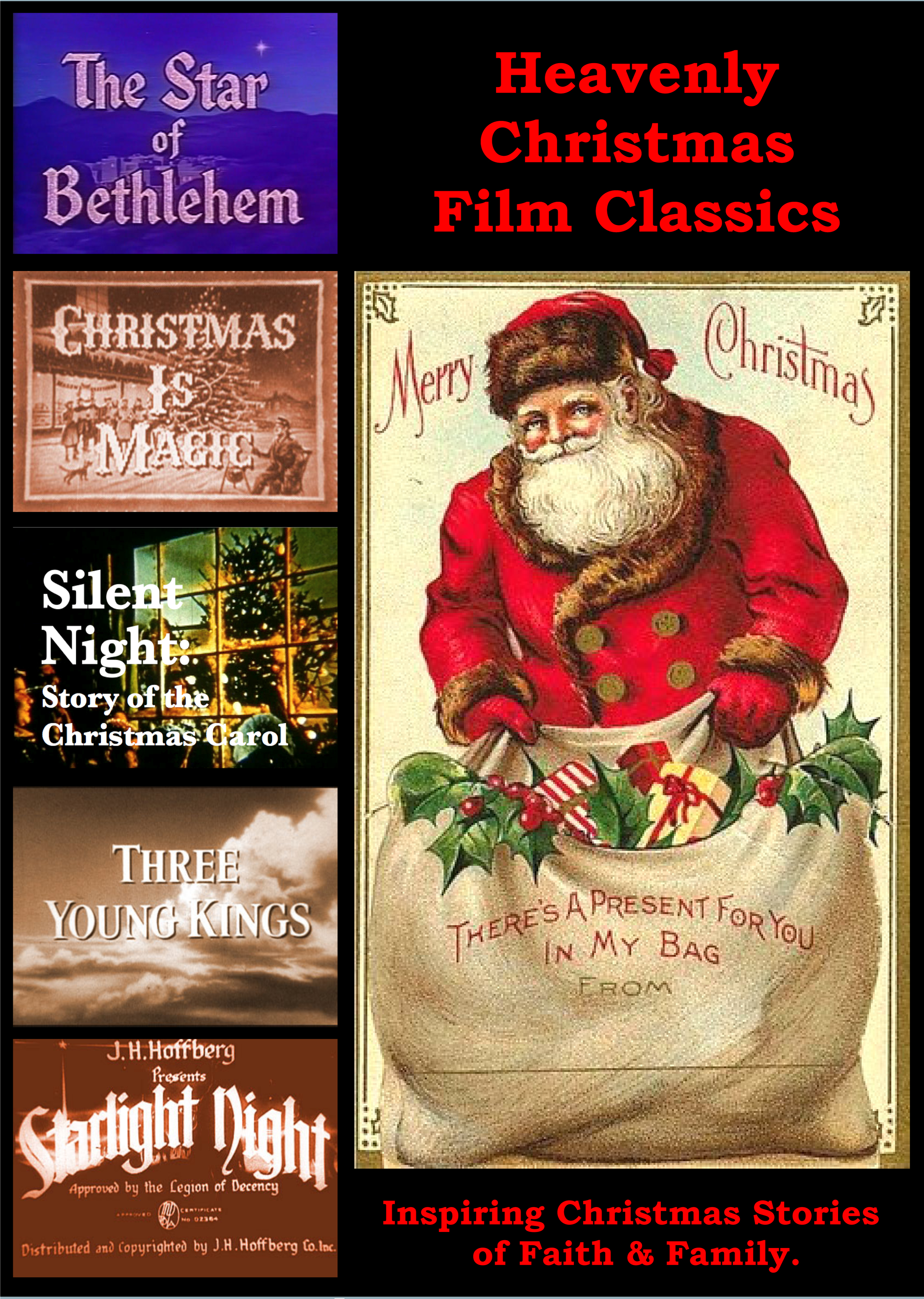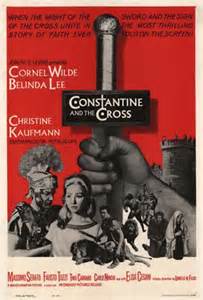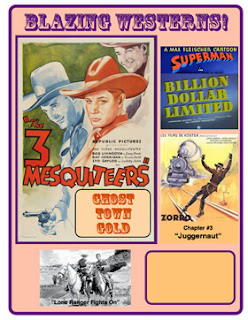 Heavenly Christmas Film Classics
Heavenly Christmas Film Classics6 rare films in an exclusive DVD that makes a nice Christmas gift! Special price to blog readers -- just $15, postage included!
Silent Night: Story of the Christmas Carol
(1953) 13 min., color. Beautifully told true story of how Franz Gruber created the iconic 1818 Christmas carol.
(1953) 13 min., color. Beautifully told true story of how Franz Gruber created the iconic 1818 Christmas carol.
Christmas is Magic
(1953) 24 min. Robert Hutton plays a war vet with amnesia who is taken in by widow Frances Rafferty and her son on Christmas Eve. You can watch the complete film below.
(1953) 24 min. Robert Hutton plays a war vet with amnesia who is taken in by widow Frances Rafferty and her son on Christmas Eve. You can watch the complete film below.
Star of Bethlehem
(1956) 12 min., color. The Nativity told using the silhouette animation style of Lotte Reiniger.
(1956) 12 min., color. The Nativity told using the silhouette animation style of Lotte Reiniger.
Three Young Kings
(1956) 28 min. Episode of “DuPont Theater.” In Latin America three boys follow a village tradition of carrying Christmas gifts to the mission church children dressed as the Three Wise Men. In the poor section of town they give the presents to the ragged children instead, causing a crisis in conscience over the true meaning of giving.
(1956) 28 min. Episode of “DuPont Theater.” In Latin America three boys follow a village tradition of carrying Christmas gifts to the mission church children dressed as the Three Wise Men. In the poor section of town they give the presents to the ragged children instead, causing a crisis in conscience over the true meaning of giving.
Star of Bethlehem
(1954) 26 min. Produced, directed by and starring James Mason. After Mason reads sections from the bible that lead up to the birth of Jesus, the Nativity is enacted starring a cast of children. A heartfelt, inventive and personal religious project by a Hollywood star.
(1954) 26 min. Produced, directed by and starring James Mason. After Mason reads sections from the bible that lead up to the birth of Jesus, the Nativity is enacted starring a cast of children. A heartfelt, inventive and personal religious project by a Hollywood star.
Starlight Night
(1939) 30 min. Opulent British docu-drama about the creation of the famous Christmas carol centers on a stern father estranged from his daughter.
(1939) 30 min. Opulent British docu-drama about the creation of the famous Christmas carol centers on a stern father estranged from his daughter.
Order from Ron Hall -- fesfilms@aol.com -- or 952-470-2172

Religious Films
I recently added a page of RELIGIOUS FILMS to my website and list them here. Most of these have been available for some years. However, in 2014 we plan to release many similar but much rarer films for the first time on video. Details soon!
Feature Films:
CONSTANTINE AND THE CROSS
(1961, color) 120 min. Cornel Wilde. Somewhat fictionalized dramatic account of Late Roman Emperor Constantine, his rise to power, and his establishment of religious tolerance among Roman subjects.
DAVID AND GOLIATH
(1960, color) 92 min. Orson Welles stars as King Saul. The story is adapted from the Old Testament: The Philistines declare war on the Israelites and wrench the Arch of the Allience from them. Saul, the king of Israel, listens meanwhile to the words of the prophets who tell him that the new king will be a young shepard called David. But still David has to fight the enemy in form of their mighty giant Goliath.
ESTHER AND THE KING
(1960, color, Italy) 109 min. Joan Collins stars in the biblical story about Esther, an orphan raised by a relative named Mordecai, as she is chosen from all the maidens in the land to become queen. She must risk her life to save her people from a treacherous plan of the charmingly wicked prince Haman.
THE GOSPEL ACCORDING TO ST. MATTHEW
(1964, Italy, subtitled) 130 min. Director Pier Paolo Pasolini's celebrated life of Christ story stars Enrique Irazoqui as Jesus. Filmed in the actual locations.
MARTIN LUTHER
(1953) 106 min. The first motion picture portrayal of the incendiary beginnings of the Protestant Reformation. This excellent film brings to life Luther's growing realization that the religion, to which he had dedicated his life, was flawed. His character is shown to mature in believable stages, culminating in acts of ferocious courage.
THE OLD TESTAMENT
(1962, Italy/France, color) 89 min. The Jews of Jerusalem are driven out by their Syrian rulers. They gather their forces, and return to drive out their oppressors.
SAUL AND DAVID
(1964, Spain/Italy, color) 113 min. The story of the relationship between David the slayer of Goliath and Saul the King of the Israelites.
Church Films
Films by Family Films, Cathedral Films and similar religious groups to spread the Gospel. These were shown primarily in churches or on Sunday morning TV. Many were intentionally released into the public domain to find the widest possible audience.
Films by Family Films, Cathedral Films and similar religious groups to spread the Gospel. These were shown primarily in churches or on Sunday morning TV. Many were intentionally released into the public domain to find the widest possible audience.
ALL THAT I HAVE
(1949, Family Films) Dr. Charles Greyson is a famous and wealthy former surgeon. His nephews take him to court to challenge his competency, due to his recent inexplicable gifts of large amounts of cash to the church. Message being that all that we are we owe to God, and the profits gained from our God-given abilities require care and thought before sharing.
THE LIFE OF CHRIST (aka. The Living Christ Series)
(1951, color) 300 min. Cathedral Films. Each of the twelve 20-30 min. programs faithfully illustrate aspects of the teachings and the ministry of Jesus Christ, in chronological order, from the Nativity in Bethlehem, to the Garden of Gethsemane and the Last Supper. The Life of Christ gives historical context with maps and graphics, and the believable dialogue makes these Bible stories come alive. Robert Wilson gives a strong, sensitive performance as Jesus Christ. Here is more info.
OLD TESTAMENT SCRIPTURES
(1955, color) 212 min. Concordia/Family Films series relates stories from the Old Testament: Abraham, Jacob, Joseph, Moses, Joshua, Gideon, Ruth, Samuel, David, Solomon and Elijah.
PILGRIMAGE PLAY
(1949,color) 92m. A Roland Reed Production tells the story of the life of Jesus Christ, starring Nelson Leigh as Jesus.
REACHING FROM HEAVEN
(1948) 80 min. Drama with strong spiritual overtones that concerns itself with the eternal question, "Can the God whose hand formed the sun and the moon and the stars be concerned about the lives of little men?" In a small American town we meet one such "little man," a European immigrant long-separated from his wife by the war.
POWER OF THE RESURRECTION
(1958, color) 60 min., Family Films. A young man, facing torture and possibly death for his Christian beliefs, confesses his fears to Peter, who awaits a similar fate. Peter tells him of fear he felt in following Jesus' arrest in the Garden of Gethesamene, when he denied knowing him three times - and yet Jesus told him that he would be the rock upon which the Church was built. Peter goes on to relate the events of the passion week, including the Christ's crucifixion, resurrection and ascension.
The Gospel on Television
Mainstream TV shows with a religious theme that often showed around Christmas or Easter.
HILL NUMBER ONE
(1951) 57 min. Family Theater Production. A respectful interpretation of what might have happened among Jesus's followers in the three days before Crucifixion. The story is told in the modern context of an US Army company stationed in Korea during the Korean War.
THE NATIVITY
(1952) 59 min. Hurd Hatfield, Robert Shaw, Paul Tripp in dramatization of the birth of Jesus was produced for television by Studio One.
PICTURE OF THE MAGI
25 min. In 1956 Communist-dominated Hungary young Aranka (Judy Morris) stumbles across the hideout of three ruthless blackmarket smugglers. When the girl discovers one of the men is named Melchoir (Walter Coy) she believes they are actually the Three Wise Men.
PONTIUS PILATE
(1952) 59 min. Episode of Westinghouse Studio One TV series. Cast: Geraldine Fitzgerald, Cyril Ritchard, Francis Sullivan. The tale of Pontius Pilate, the Roman administrator of Judea and the man charged with trying and sentencing Jesus to death, in spite of his reservations.
A STAR SHALL RISE
(1952) 29 min. Raymond Burr stars in the story of the birth of Jesus and the visit of the three wise men.
Crossroads
(1955-'57) Half-hour TV anthology series dramatizes the lives of clergymen of all faiths and the problems they face in both their professional and personal lives.
(1955-'57) Half-hour TV anthology series dramatizes the lives of clergymen of all faiths and the problems they face in both their professional and personal lives.
A Bell for O'Donnell -- A reverend learns a lesson in forgiveness when is is swindled by a fast-talking con man (Edmond Lowe).
Cleanup -- A pastor (Vincent Price) exhorts his parishioners to take back their city from the gangsters and corrupt politicians who have taken it over.
Call for Help -- Richard Carlson plays a priest who works with troubled youths, when a gang fight leads to a fatal shooting.
Dig or Die, Brother Hyde -- A new preacher on the harsh Dakota frontier is severly tested. With Hugh Marlow.
God's Healing -- Vincent Price plays a priest who heals an old woman's embittered heart.
The Good Thief -- US Army chaplain (James Whitmore) is tortured by Red Chinese captors for ministering to his fellow prisoners of war.
The Judge -- Brian Donlevy does double duty in a lawless town as a preacher and a judge.
Mother O'Brien -- A police detective is torn between family and duty when his younger brother is involved in a petty crime.
A Christmas Mystery....
Christmas is Magic is one of the six films on our Heavenly Christmas Film Classics DVD release promoted at the top. An extraordinary discovery was brought to our attention last Christmas by a customer the day before Christmas Eve -- a vision of the face of Jesus Christ appears several times. The face of Jesus is clear to both Christians and non-believers alike in numerous scenes.Because the Face appears more than once, it may have been an intentional although subliminal insertion by the film's producer, Sovereign Films. Another theory is that it is an artifact of the 16mm to video transfer process. Yet others may claim that we altered the film to attract publicity, and I can assure everyone that is not at all the case. The DVD was released by Festival Films over three months ago and today is the first time I and my two partners became aware of this phenomena.
Christmas is Magic was the Christmas episode of an anthology TV series called Your Jeweler's Showcase. It was first shown on television on Dec. 13, 1953, and may have been syndicated on 16mm prints for a few years. Our source is an original 16mm syndication print.
A WW-2 war veteran (Robert Hutton) with amnesia gets off a train in a town he never heard of on Christmas Eve. In the village square he meets a young widow (Frances Rafferty) whose husband was killed in the war and her 8-year-old son. The son and man, who calls himself John Doe for lack of his real name, quickly bond and he goes home with them to wait for Santa to arrive. The mother and son pray together in a moving scene not often found on television. Later John Doe helps trim the tree while the widow helps him remember his past. Miracles happen.
 |
| Robert Hutton and Frances Rafferty |
We urge you to watch the film from the beginning to end first to experience the full effect of the story, then explore the Face. Still pictures do not capture the Face of Jesus Christ very well. It is much more apparent in the youtube video just below. Most will see it -- eyes, nose, nostrils, beard and hair in the traditional image of Christ as depicted on the Shroud of Turin and in religious paintings. One can see faces in almost anything, but this has symmetry, does not disappear after a few frames and is, of course, a very special face. Look closely at the fabric of Robert Hutton's tweed suit from 14:00 to 14:25. Once you see the Face you will spot it in other scenes both before and after. The indication of a face could be a coincidence or it could have been woven into the fabric on purpose. You decide. By all means, tell your friends! Spread the mystery. Spread the word. Spread the joy. Foremost, enjoy the film!
And the merriest of all Christmases to every one of you!
Visit my websites at Festival Films and Lost and Rare.
































